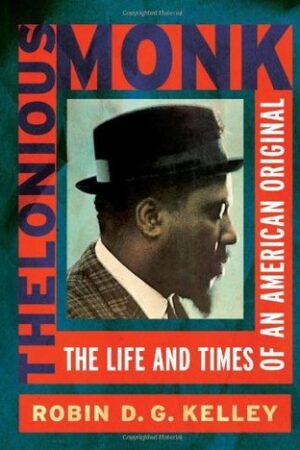Thelonious Monk: The Life and Times of an American Original
by Robin D. G. Kelley
reviewed by Amor Kohli
For about a decade, Robin D. G. Kelley’s biographical blurbs have listed him as the author of a forthcoming biography of the musician Thelonious Monk. We can finally remove that “forthcoming” and, with this generous, exhaustively researched new book, forgive Kelley for making us wait so long.
Kelley delivers a portrait of a playful, enigmatic pianist and composer who was the subject of incessant unofficial attempts at definition. Kelley’s energies are directed at the frustrating and often destructive mythmaking that was usually out of Monk’s control, but to which he sometimes lent credence through his actions. He attacks the myth of Monk as an unreliable, drug-addled crazyman given to eccentricities and downright antisocial behaviors. This book’s Monk is no Sambo-savant, but an emphatically dedicated, visionary craftsman who, yes, had his quirks.
In this biography, Kelley does the crucial work of pulling the story of Monk from myth into the world, situating his subject in a web of contexts. He takes seriously his twin tasks of reconstructing a life and analyzing a music, but also responds to the call of his own pedagogical imperatives. While exhaustively presenting the particulars of the lives of Monk and his family, Kelley smoothly leads his readers through the broader historical and political frameworks, beginning with the first chapter, which effortlessly blends genealogy with a thoughtful consideration of American slavery and Reconstruction.
Kelley accepts the task of clarifying this history for a mainstream audience, briefly commenting, for instance, on the strength of slave marriages or black American responses to the Emmett Till murder in a way that further illuminates the narrative of Monk’s life. Monk has been quoted as saying that his music was not “political,” but Kelley gently rebuts this notion, showing that while Monk’s music may not have been overtly political, he was keenly aware of the world that surrounded him as a black man in the mid-century United States.
Monk’s music, described by one reviewer as a “moving canvas,” is complex, especially for the neophyte. Known for its intricate rhythms and idiosyncratic use of accents and silences, it comprises a spare, percussive, often dissonant sound that nonetheless showcases Monk’s stride piano roots and his unfailing adherence to the primacy of melody. Kelley handles the musical analysis with a welcome balance between technical and emotive vocabularies and with an eye always toward accessibility.
Sometimes this urge for accessibility can go overboard. Although Kelley’s language crackles with enthusiasm and a generosity of spirit, he is susceptible to colloquialisms that swerve uncomfortably close to cliché. If there is a larger weakness in this work, it is perhaps that, given Kelley’s monumental approach, thoroughness comes at the expense of selectivity. Kelley appears to leave nothing untouched or unaddressed, and while this is useful, the narrative flow sometimes suffers.
Still, what else would we have him do? If we’re interested in the full story, we get it. Monk is shown as an often-combustible mix of the supremely self-assured and the easily wounded. Confident in the importance of his own contribution, he did what he wanted—a quality that lent itself to breathtaking innovation but also to not-wholly unfounded allegations of erraticism and undependability.
Conversely, Kelley illustrates Monk’s thirst for recognition. He rightly resented being left out of the narrative of bebop’s meteoric rise; then, when avant-garde jazz was gaining in notoriety, he argued that for years he’d been doing what was being heralded as utterly new. Fellow musicians were often willing to give him the respect he craved, but the press focused on what was regularly called his “weirdness.” It is a term that, as Kelley repeatedly demonstrates, was interchangeably employed in sartorial, behavioral, and musical assessments of Monk. But the saxophonist Johnny Griffin has a more perfectly pitched appraisal of the man whose creative integrity and innovation animates this book: “He played what he wanted to play and he did it perfectly.”
Published on June 21, 2013

